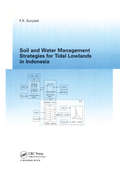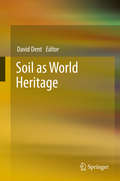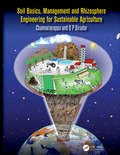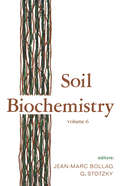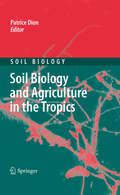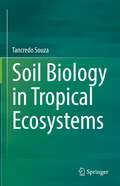- Table View
- List View
Soil and Water Management Strategies for Tidal Lowlands in Indonesia
by F. X. SuryadiThis book presents a methodology to support the development of soil and water management strategies for tidal lowlands in general and Indonesian tidal lowlands in particular. It analyzes and evaluates the potential of tidal lowlands for agricultural development.
Soil and Water Management Strategies for Tidal Lowlands in Indonesia
by Fransiscus Xaverius SuryadiThis book presents a methodology to support the development of soil and water management strategies for tidal lowlands in general and Indonesian tidal lowlands in particular. It analyzes and evaluates the potential of tidal lowlands for agricultural development.
Soil and Water Pollution Monitoring, Protection and Remediation (Nato Science Series: IV: #69)
by Sebastian StefaniakThis book details the state-of-the art in early warning monitoring of anthropogenic pollution of soil and water. It is unique with regard to its complex, multidisciplinary, mechanistic approach. Top scientists establish links and strengthen weak connections between specific fields in biology, microbiology, chemistry, biochemistry, toxicology, sensoristics, soil science and hydrogeology.
Soil as World Heritage
by David DentSoil as World Heritage celebrates a half century of field experiments on the Balti Steppe, in Moldova - where Dokuchaev first described the Typical Chernozem in 1877, protected from the elements by a unique system of shelter belts designed by the great man, and now provisionally listed as the first World Heritage Site for soil. The book presents contributions to the 2012 international symposium attended by researchers, practitioners and policy makers from the European Commission and countries as diverse as Belarus, Bulgaria, the Czech Republic, France, Germany, Italy , the Netherlands, Romania, Russia, Ukraine, United Kingdom, USA and, of course, Moldova itself. The experimental data demonstrate the damage caused by human activity to the productivity and integrity of the black earth and, also, ways to restore its fertility. Results from even longer-established trials worldwide also demonstrate that agricultural practices are driving global warming, leaching of nutrients, pollution of water resources, diversion of rainfall away from replenishment of soil and groundwater to destructive runoff, and destroying soil organic matter and biodiversity. These are pressing issues for our generation and will press harder on future generations. Long-term field experiments, and the scientific skills and experience that they nurture, will be more and more valuable as a foundation and focus for interdisciplinary teams studying the effects of farming practices on the soil and soil life so as to devise a sustainable alternative. Europe-wide and worldwide contributions also discuss economic incentives - carbon and green water credits - which themselves require robust supporting data, and legislative aspects of promoting more sustainable farming systems. The outcomes of the conference include recommendations for institutional support for sustainable farming and a draft of the law on land and soil management for the Parliament of Moldova.
Soil Basics, Management and Rhizosphere Engineering for Sustainable Agriculture
by Channarayappa C. D P BiradarIncrease in global population, drastic changes in the environment, soil degradation and decrease in quality and quantity of agricultural productivity warranted us to adapt sustainable farming practices. This book focuses on soil health management and creating biased rhizosphere that can effectively augment the needs of sustainable agriculture.
Soil Basics, Management and Rhizosphere Engineering for Sustainable Agriculture
by Channarayappa C. D P BiradarIncrease in global population, drastic changes in the environment, soil degradation and decrease in quality and quantity of agricultural productivity warranted us to adapt sustainable farming practices. This book focuses on soil health management and creating biased rhizosphere that can effectively augment the needs of sustainable agriculture.
Soil Behavior and Characterization of Geomaterials: Proceedings of Indian Geotechnical Conference 2021 Volume 1 (Lecture Notes in Civil Engineering #296)
by Kasinathan Muthukkumaran Ravi Sankar Jakka C. R. Parthasarathy B. SoundaraThis book comprises the select peer-reviewed proceedings of the Indian Geotechnical Conference (IGC) 2021. The contents focus on Geotechnics for Infrastructure Development and Innovative Applications. The book covers topics related to soil behavior and characterization of geomaterials, geotechnical, geological, and geophysical investigation of special topics such as behavior of unsaturated soils, offshore and marine geotechnics, remote sensing and GIS, instrumentation and monitoring, retrofitting of geotechnical structures, reliability in geotechnical engineering, geotechnical education, codes and standards, among others. This volume will be of interest to those in academia and industry.
Soil Biochemistry: Volume 8
by Jean-Marc Bollag G. StotzkyStressing the potential application of biochemical processes in soil to environmental biotechnology, this state-of-the-art reference considers the vital role that such biochemical processes have in the environment - emphasizing the activity of micro-organisms in soil.;An up-to-date analysis of biological reactions in soil, Volume 8 of Soil Biochemistry highlights: traditional as well as molecular and immunlogical techniques for detecting specific micro-organisms in soil; the fate of introduced genetically-modified organisms; the problem of competition by the indigenous microbial populations with the introduced organisms; the use of a white rot fungus, Phanerochaete chrysosporium, for bioremediative purposes in soil; the interaction of xenobiotics, such as pesticides, with soil organisms; generic microbial metabolism and degradation pathways; the inhibition of the nitrification process by allelochemicals released by plants; the microbial mineralization of various compounds under anaerobic conditions, explaining its importance in the global carbon cycle; the formation of soil organic matter, particularly in forest soils; and CPMAS 13C-NMR spectroscopy, a major analytical technique to determine the chemicals or chemical groups involved in the humification process.;Presenting a multidisciplinary approach to the field by internationally acclaimed scientists, Soil Biochemistry, Volume 8 is intended for professionals and students in the fields of soil science; microbiology; biochemistry; environmental science, engineering and technology; biogeochemistry; biotechnology; agronomy; plant pathology; and microbial ecology.
Soil Biochemistry: Volume 7
by Jean-Marc Bollag G. StotzkyThis book describes the interactions between soil minerals and microorganisms to more specialized areas such as the formation of desert varnishes. It is helpful for scientists and students who want to extend their knowledge of and research into soil biochemistry.
Soil Biochemistry: Volume 7
by Jean-Marc Bollag G. StotzkyThis book describes the interactions between soil minerals and microorganisms to more specialized areas such as the formation of desert varnishes. It is helpful for scientists and students who want to extend their knowledge of and research into soil biochemistry.
Soil Biochemistry: Volume 8
by Jean-Marc Bollag G. StotzkyStressing the potential application of biochemical processes in soil to environmental biotechnology, this state-of-the-art reference considers the vital role that such biochemical processes have in the environment - emphasizing the activity of micro-organisms in soil.;An up-to-date analysis of biological reactions in soil, Volume 8 of Soil Biochemistry highlights: traditional as well as molecular and immunlogical techniques for detecting specific micro-organisms in soil; the fate of introduced genetically-modified organisms; the problem of competition by the indigenous microbial populations with the introduced organisms; the use of a white rot fungus, Phanerochaete chrysosporium, for bioremediative purposes in soil; the interaction of xenobiotics, such as pesticides, with soil organisms; generic microbial metabolism and degradation pathways; the inhibition of the nitrification process by allelochemicals released by plants; the microbial mineralization of various compounds under anaerobic conditions, explaining its importance in the global carbon cycle; the formation of soil organic matter, particularly in forest soils; and CPMAS 13C-NMR spectroscopy, a major analytical technique to determine the chemicals or chemical groups involved in the humification process.;Presenting a multidisciplinary approach to the field by internationally acclaimed scientists, Soil Biochemistry, Volume 8 is intended for professionals and students in the fields of soil science; microbiology; biochemistry; environmental science, engineering and technology; biogeochemistry; biotechnology; agronomy; plant pathology; and microbial ecology.
Soil Biochemistry: Volume 6: Volume 6
by J.-M. BollagExplores the role of biochemical processes in the soil environment, particularly the activity of microorganisms, and the potential application of those processes to environmental biotechnology. The 11 papers also highlight the application of molecular biology and microbial genetics to soil biology a
Soil Biochemistry: Volume 6: Volume 6
by J.-M. BollagExplores the role of biochemical processes in the soil environment, particularly the activity of microorganisms, and the potential application of those processes to environmental biotechnology. The 11 papers also highlight the application of molecular biology and microbial genetics to soil biology a
Soil Biochemistry, Volume 10
by Guenther StotzkyAn exploration of the most complex microbial ecosystems with incisive reviews of developments in soil science. It presents techniques of chemical analysis, refinements of environmental protection measures, and methods for maximizing agricultural yields. It also addresses a wide range of biochemical processes and practical applications of advanced b
Soil Biological Communities and Ecosystem Resilience (Sustainability in Plant and Crop Protection)
by Martin Lukac Paola Grenni Mauro GamboniThis volume explores current knowledge and methods used to study soil organisms and to attribute their activity to wider ecosystem functions. Biodiversity not only responds to environmental change, but has also been shown to be one of the key drivers of ecosystem function and service delivery. Soil biodiversity in tree-dominated ecosystems is also governed by these principles, the structure of soil biological communities is clearly determined by environmental, as well as spatial, temporal and hierarchical factors. Global environmental change, together with land-use change and ecosystem management by humans, impacts the aboveground structure and composition of tree ecosystems. Due to existing knowledge of the close links between the above- and belowground parts of terrestrial ecosystems, we know that soil biodiversity is also impacted. However, very little is known about the nature of these impacts; effects on the overall level of biodiversity, the magnitude and diversity of functions soil biodiversity generates, but also on the present and future stability of tree ecosystems and soils. Even though much remains to be learned about the relationships between soil biodiversity and tree ecosystem functionality, it is clear that better effort needs to be made to describe and understand key processes which take place in soils and are driven by soil biota.
Soil Biology: Effects on Soil Quality
by J. L. HatfieldSoil Biology is a state-of-the art review focusing on the linkage between biological processes that occur in the soil and their impact on soil quality. Topics considered include the microbial ecology of conservation management systems, dynamic processes of vesicular-arbuscular mycorrhizae, earthworms and soil fauna, microbial processes in the soil, and the degradation of pesticides through microbial processes. The book will interest soil scientists, microbiologists, agronomists, and soil ecologists.
Soil Biology: Effects on Soil Quality
by J. L. HatfieldSoil Biology is a state-of-the art review focusing on the linkage between biological processes that occur in the soil and their impact on soil quality. Topics considered include the microbial ecology of conservation management systems, dynamic processes of vesicular-arbuscular mycorrhizae, earthworms and soil fauna, microbial processes in the soil, and the degradation of pesticides through microbial processes. The book will interest soil scientists, microbiologists, agronomists, and soil ecologists.
Soil Biology and Agriculture in the Tropics (Soil Biology #21)
by Patrice DionThe relationships between soils, microbes and humans are of crucial relevance in the tropics, where plant stress and microbial activity are exacerbated. This volume of Soil Biology presents the living component of tropical soils, showing how it is shaped by environmental conditions and emphasizing its dramatic impact on human survival and well-being. Following an introduction to the specificities of tropical soils and of their microbial communities, the biological aspects of soil management are examined, dealing with land use change, conservation and slash-and-burn agriculture, the restoration of hot deserts, agroforestry and paddy rice cultivation. As they are of particular relevance for tropical agriculture, symbioses of plants and microbes are thoroughly covered, as are the biodegradation of pesticides and health risks associated with wastewater irrigation. Lastly, traditional soil knowledge is discussed as a key to our sustainable presence in this world.
Soil Biology in Tropical Ecosystems
by Tancredo SouzaThis textbook explores the complex nature of soil biological communities and their environments, and covers deserts, rainforests, seasonal tropical forests, dry deciduous forests, and island environments in the tropical zone. It provides essential information on soil biology concepts, ecological processes, plant-soil feedback, trophic structure, and land use effects on soil’s biological properties. The book also offers an updated approach to soil biota and microbiota and their interactions with plants that regulate the structures and functions of tropical ecosystems. Uniquely, it addresses island environments and natural disasters, shedding new light on soil organisms recovering tropical ecosystem functions. Further topics include ecological processes, plant-soil interactions, trophic communities, molecular approaches, and land use, making the book a valuable asset for students, educators and researchers engaged in the Environmental Sciences, Biodiversity and Conservation, Soil Ecology, Soil Biology, Ecology, Zoology, and Soil Biota Classification using classical and molecular tools.
Soil Bioventing: Principles and Practice
by Andrea Leeson Robert E. HincheeSoil bioventing is one of the most popular modern techniques for removing contaminants from soil. It has recently emerged as one of the most cost-effective and efficient technologies available for vadose zone remediation of petroleum-contaminated sites. This book explains in practical terms how to carry out a bioventing program. It is an interdisciplinary treatment of the subject, covering everything from basic physical and chemical properties of soils to site evaluation, project design, and post-bioventing monitoring.The wide breadth of coverage makes Soil Bioventing useful to a large audience, including consulting firms, students, contractors, environmental managers, and anyone who is responsible for supervision of soil cleanup for regulatory reasons.
Soil Bioventing: Principles and Practice
by Andrea Leeson Robert E. HincheeSoil bioventing is one of the most popular modern techniques for removing contaminants from soil. It has recently emerged as one of the most cost-effective and efficient technologies available for vadose zone remediation of petroleum-contaminated sites. This book explains in practical terms how to carry out a bioventing program. It is an interdisciplinary treatment of the subject, covering everything from basic physical and chemical properties of soils to site evaluation, project design, and post-bioventing monitoring.The wide breadth of coverage makes Soil Bioventing useful to a large audience, including consulting firms, students, contractors, environmental managers, and anyone who is responsible for supervision of soil cleanup for regulatory reasons.
Soil Carbon: Science, Management and Policy for Multiple Benefits
by Dave Abson Christiano Ballabio Francesca Bampa Andre Bationo Niels Batjes Martial Bernoux Tapas Bhattacharyya Daniel Buschiazzo Carlos Eduardo Cerri Rich Conant Heitor L.C. Coutinho Chris Duffy Christian Feller Roger Funk Patrick Gicheru Marty Goldhaber Hans Joosten Pierre-Alain Maron Luca Montanarella Generose Nziguheba Genxing Pan Unai Pascual David Powlson Pete Smith Meine Van Noordwijk Bas Van Wesemael David Werner Yongcun ZhaoThis book brings together the essential evidence and policy opportunities regarding the global importance of soil carbon for sustaining Earth's life support system for humanity. Covering the science and policy background for this important natural resource, it describes land management options that improve soil carbon status and therefore increase the benefits that humans derive from the environment. Written by renowned global experts, it is the principal output from a SCOPE rapid assessment process project.
Soil Carbon Dynamics in Indian Himalayan Region
by Gaurav Mishra Krishna Giri Arun Nath Rosa FrancavigliaThe contributed volume assimilates the knowledge, experience, and exciting aspects of soil carbon research in the Indian Himalayan region. It includes different aspects and factors associated with soil carbon sequestration in the region, one of the biodiversity hot spots and highly vulnerable to climatic change impacts. Information on different aspects of soil organic carbon dynamics concerning adaptive land management practices and anthropogenic impacts is covered. Further topics include applying advanced tools and techniques to soil carbon vis-a-vis soil erosion research. This book is of interest to researchers and policymakers involved in soil carbon research and offer ideas to enhance the soil carbon in the region concerned. In addition, the book will provide up-to-date information for researchers interested in soil carbon research for the maintenance of soil quality and fertility in the climate-vulnerable Indian Himalayan region.
Soil Carbon in Sensitive European Ecosystems: From Science to Land Management
by Robert JandlSoil Carbon in Sensitive European Ecosystems - From Science to Land Management is a comprehensive overview of the latest research in this field drawn together by a network of scientists from across Europe. Soil carbon assessments are crucial at present to our understanding of the dynamics of terrestrial ecosystems and our ability to assess implications for the global carbon exchange and its consequences on the future climate. This book focuses primarily on ecosystems and their soil carbon stocks. The book identifies three key sensitive ecosystems within Europe: Mediterranean Forest and Agricultural Systems; Mountains; and Peatland. Contributors include those currently working for the European research programme, COST Action 639 BurnOut (www.cost639.net; 2006-2010). COST Action 639 emerged from a demand from policy makers in Europe for more detailed information on soil carbon dynamics. The cooperation between experts for reporting and experts for soil dynamics is the focus of the book. This book seeks to provide an up-to-date account on the state-of-the-art research within this topical field.
Soil Carbon in Sensitive European Ecosystems: From Science to Land Management
by Robert Jandl Mirco Rodeghiero Mats OlssonSoil Carbon in Sensitive European Ecosystems - From Science to Land Management is a comprehensive overview of the latest research in this field drawn together by a network of scientists from across Europe. Soil carbon assessments are crucial at present to our understanding of the dynamics of terrestrial ecosystems and our ability to assess implications for the global carbon exchange and its consequences on the future climate. This book focuses primarily on ecosystems and their soil carbon stocks. The book identifies three key sensitive ecosystems within Europe: Mediterranean Forest and Agricultural Systems; Mountains; and Peatland. Contributors include those currently working for the European research programme, COST Action 639 BurnOut (www.cost639.net; 2006-2010). COST Action 639 emerged from a demand from policy makers in Europe for more detailed information on soil carbon dynamics. The cooperation between experts for reporting and experts for soil dynamics is the focus of the book. This book seeks to provide an up-to-date account on the state-of-the-art research within this topical field.
